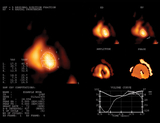MUGA Scan
What is a MUGA scan?

A MUGA (MUltiple Gated Acquisition) scan produces a moving image of the beating heart. We use it to evaluate the Left Ventricle Ejection Fraction (LVEF), which is the percent of blood being pumped from the left ventricle of the heart out to the body. The MUGA scan also shows the wall motion of the heart and the motion of the heart as it beats.
A MUGA scan can be ordered either at rest or with stress. We typically perform MUGA scans at rest. To obtain the exercise stress test format, call 215-590-2592.
We do the test by giving your child an intravenous radiopharmaceutical. This "tracer" is medicine combined with a small amount of radioactive material. It travels to the area of your child we need to see and is detected and imaged by a gamma camera.
Radiopharmaceuticals are carefully tested. The risk of side effects is extremely small. Most radiopharmaceuticals used in nuclear medicine studies give less radiation exposure than a day at the beach.
What should you do prior to the exam?
- No caffeine is allowed before the test on the day of the exam.
- Dress your child comfortably in clothes that are easily removed. Your child may be given a gown to change into for the procedure.
- We have a large variety of video entertainment to choose from. Your child may bring along a favorite movie to watch during the exam.
- You may want to bring a snack or drink for your child to have after the exam.
Note: Parents will be allowed to accompany their child into the exam room. It may be helpful to make other arrangements for siblings.
What should you expect during the exam?
- A technologist or nurse will place an IV in your child’s arm, hand or foot. Your child may feel a small pinch.
- The technologist will ask why the MUGA Scan is being done and will explain the study to you and your child.
- We will draw a small amount of blood through the IV and mix it with a radiopharmaceutical. This process takes approximately 30 minutes. The technologist will let you and your child know what to do while you wait.
- Your child's blood (with the radiopharmaceutical) will be administered back into the IV line.
- Your child will lay still on the exam table for the imaging portion of the test.
- We will take three sets of images, each set lasting five to 15 minutes. The camera will be above the table and will come close to, but will not touch your child.
- Sedation is not an option for this test.
If you’d like, our child life specialists will help you prepare and support your child during the procedure. We can also arrange to have a child life specialist at your child's appointment to explain the procedure in developmentally appropriate ways and to help your child better cope with the stress of the hospital experience.
What should you do after the exam?
There are no special instructions for your child to follow after the exam.
Test results
The images from your child's exam are interpreted on the same day and a report is sent to your physician's office.
Your physician may call 215-590-2584 with questions about the exam.